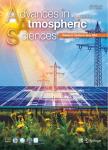Some Aspects of the Characteristics of Monsoon Disturbances Using a Combined Barotropic-Baroclinic Model
Some Aspects of the Characteristics of Monsoon Disturbances Using a Combined Barotropic-Baroclinic Model作者机构:Centre for Atmospheric Sciences Indian Institute of Technology New Delhi India
出 版 物:《Advances in Atmospheric Sciences》 (大气科学进展(英文版))
年 卷 期:1995年第12卷第4期
页 面:487-506页
核心收录:
学科分类:07[理学] 070601[理学-气象学] 0706[理学-大气科学] 0816[工学-测绘科学与技术] 0825[工学-航空宇航科学与技术]
主 题:Monsoon disturbance Rossby wave Combined barotropic-baroclinic stability
摘 要:A standing Rossby wave of wavelength 30°longitude with a finite amplitude along the meridional direction is superimposed on the zonal mean component of the monsoon flow and the stability of such a flow is examined by a quasi-geostrophic *** well as by a quasi-geostrophic combined barotropic and baroclinic model on a beta plane centered at 18°N latitude. It is found that the growth of synoptic scale disturbance increases with the amplitude of the meridional wind. The barotropic stability analysis at 700 hPa pressure level shows that there is a critical value (Umaz=11 m/s) of the maximum mean zonal wind below which the computed disturbance moves to the west due to the wave-wave superposition. For maximum mean zonal wind greater that 11m /s, the westerly wind dominates and the disturbance moves to the east. In another analysis the stability of the zonally asymmetric basic now is studied with a combined barotropic-barotropic model where cumulus heating is included. The growth rate, intensity, horizontal scale and the westward velocity of computed disturbances reasonably agree with those of observed monsoon disturbances. The fastest growing mode has a horizontal wavelength of 2000 kms and the e-folding time is about 3 days,when the meridional amplitude of the Rossby wave is 4m/ s at 700 hPa pressure level. When cumulus heating is included in the analysis the intensity of geopotential perturbation at 700 hPa disturbance is -304 m2 / s2. Energy calculations show that the kinetic energy of the mean zonal flow is the main source of energy for the perturbation to *** is also t ound that the contribution of the kinetic energy of the basic Rossby wave to the growth of perturbation is more in comparison to the available potential energy.



